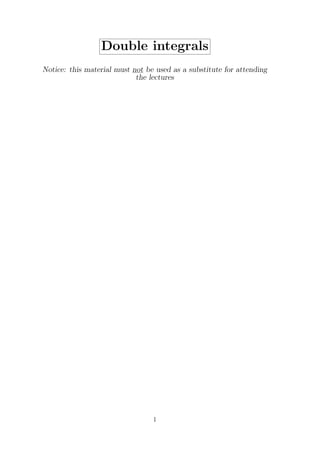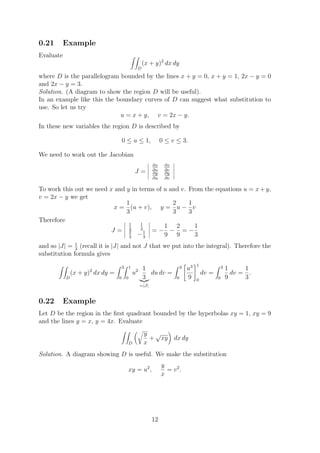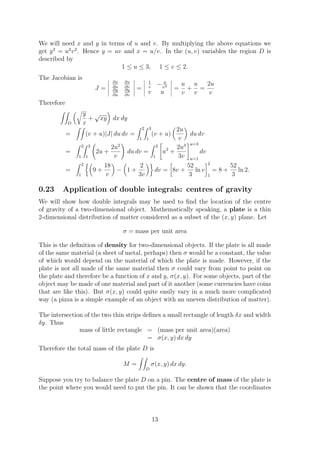This document provides examples and explanations of double integrals. It defines a double integral as integrating a function f(x,y) over a region R in the xy-plane. It then gives three key points:
1) To evaluate a double integral, integrate the inner integral first treating the other variable as a constant, then integrate the outer integral.
2) The easiest regions to integrate over are rectangles, as the limits of integration will all be constants.
3) For non-rectangular regions, the limits of integration may be variable, requiring more careful analysis to determine the limits for each integral.



![0.6 Example
Evaluate
2 x
y 2 x dy dx
0 x2
Solution.
2 x
integral = y 2 x dy dx
0 x2
y=x
2 y3x
= dx
0 3 y=x2
2
x4 x7 2 x5 x8
= − dx = −
0 3 3 15 24 0
32 256 128
= − =−
15 24 15
0.7 Example
Evaluate
π x2 1 y
cos dy dx
π/2 0 x x
1
Solution. Recall from elementary calculus the integral cos my dy = m
sin my for m
independent of y. Using this result,
2
y y=x
π1 sin x
integral = dx
π/2 x 1
x y=0
π
= sin x dx = [− cos x]π
x=π/2 = 1
π/2
0.8 Example
Evaluate √
4 y √
ex/ y
dx dy
1 0
Solution.
√ √
x= y
4ex/ y
integral = √ dy
1 1/ y x=0
4 √ √ 4
= ( ye − y) dy = (e − 1) y 1/2 dy
1 1
3/2 4
y 2
= (e − 1) = (e − 1)(8 − 1)
3/2 y=1
3
14
= (e − 1)
3
4](https://image.slidesharecdn.com/doubleintegration-130320004221-phpapp02/85/Double-integration-4-320.jpg)
![0.9 Evaluating the limits of integration
When evaluating double integrals it is very common not to be told the limits of
integration but simply told that the integral is to be taken over a certain specified
region R in the (x, y) plane. In this case you need to work out the limits of integration
for yourself. Great care has to be taken in carrying out this task. The integration
can in principle be done in two ways: (i) integrating first with respect to x and then
with respect to y, or (ii) first with respect to y and then with respect to x. The
limits of integration in the two approaches will in general be quite different, but both
approaches must yield the same answer. Sometimes one way round is considerably
harder than the other, and in some integrals one way works fine while the other leads
to an integral that cannot be evaluated using the simple methods you have been
taught. There are no simple rules for deciding which order to do the integration in.
0.10 Example
Evaluate
(3 − x − y) dA [dA means dxdy or dydx]
D
where D is the triangle in the (x, y) plane bounded by the x-axis and the lines y = x
and x = 1.
Solution. A good diagram is essential.
Method 1 : do the integration with respect to x first. In this approach we select a typical
y value which is (for the moment) considered fixed, and we draw a horizontal
line across the region D; this horizontal line intersects the y axis at the typical
y value. Find out the values of x (they will depend on y) where the horizontal
line enters and leaves the region D (in this problem it enters at x = y and
leaves at x = 1). These values of x will be the limits of integration for the inner
integral. Then you determine what values y has to range between so that the
horizontal line sweeps the entire region D (in this case y has to go from 0 to 1).
This determines the limits of integration for the outer integral, the integral with
respect to y. For this particular problem the integral becomes
1 1
(3 − x − y) dA = (3 − x − y) dx dy
D 0 y
x=1
1 x2
= 3x − − yx dy
0 2 x=y
1 y2
= 3 − 1 − y − 3y −
2
− y2 dy
0 2
y=1
5 1 3 5y y3
= − 4y + y 2 dy = − 2y 2 +
0 2 2 2 2 y=0
5 1
= −2+ =1
2 2
5](https://image.slidesharecdn.com/doubleintegration-130320004221-phpapp02/85/Double-integration-5-320.jpg)

![Method 2 : Integrate first with respect to y and then x, i.e. draw a vertical line across D
at a typical x value. Such a line enters D at y = x2 and leaves at y = 2x. The
integral becomes
2 2x
(4x + 2) dA = (4x + 2) dy dx
D 0 x2
2
= [4xy + 2y]y=2x dx
y=x2
0
2
= 8x2 + 4x − 4x3 + 2x2 dx
0
2 2
= (6x2 − 4x3 + 4x) dx = 2x3 − x4 + 2x2 =8
0 0
The example we have just done shows that it is sometimes easier to do it one way
than the other. The next example shows that sometimes the difference in effort is
more considerable. There is no general rule saying that one way is always easier than
the other; it depends on the individual integral.
0.12 Example
Evaluate
(xy − y 3 ) dA
D
where D is the region consisting of the square {(x, y) : −1 ≤ x ≤ 0, 0 ≤ y ≤ 1}
together with the triangle {(x, y) : x ≤ y ≤ 1, 0 ≤ x ≤ 1}.
Method 1 : (easy). integrate with respect to x first. A diagram will show that x goes
from −1 to y, and then y goes from 0 to 1. The integral becomes
1 y
(xy − y 3 ) dA = (xy − y 3 ) dx dy
D 0 −1
1 x2 x=y
3
= y − xy dy
0 2 x=−1
1 y3
= − y 4 − ( 2 y + y 3 ) dy
1
0 2
1
1 y3 y4 y5 y2 23
= − − y4 − 2 y
1
dy = − − − =−
0 2 8 5 4 y=0
40
Method 2 : (harder). It is necessary to break the region of integration D into two sub-
regions D1 (the square part) and D2 (triangular part). The integral over D is
given by
(xy − y 3 ) dA = (xy − y 3 ) dA + (xy − y 3 ) dA
D D1 D2
7](https://image.slidesharecdn.com/doubleintegration-130320004221-phpapp02/85/Double-integration-7-320.jpg)
![c b c
which is the analogy of the formula a f (x) dx = a f (x) dx + b f (x) dx for
single integrals. Thus
0 1 1 1
(xy − y 3 ) dA = (xy − y 3 ) dy dx + (xy − y 3 ) dy dx
D −1 0 0 x
1 1
0 xy 2 y 4 1 xy 2 y 4
= − dx + − dx
−1 2 4 y=0 0 2 4 y=x
3
0
1 1 1 x 1 x x4
= 2
x − dx + − − − dx
−1 4 0 2 4 2 4
0 1
x2 x x2 x x4 x5
= − + − − +
4 4 −1 4 4 8 20 0
3 23
= −1 −
2
=−
40 40
In the next example the integration can only be done one way round.
0.13 Example
Evaluate
sin x
dA
D x
where D is the triangle {(x, y) : 0 ≤ y ≤ x, 0 ≤ x ≤ π}.
Solution. Let’s try doing the integration first with respect to x and then y. This gives
sin x π π sin x
dA = dx dy
D x 0 y x
but we cannot proceed because we cannot find an indefinite integral for sin x/x. So,
let’s try doing it the other way. We then have
sin x π
sin x x
dA = dy dx
D x 0 0 x
π sin x x π
= y dx = sin x dx
0 x y=0 0
= [− cos x]π = 1 − (−1) = 2
0
0.14 Example
Find the volume of the tetrahedron that lies in the first octant and is bounded by the
three coordinate planes and the plane z = 5 − 2x − y.
Solution. The given plane intersects the coordinate axes at the points ( 5 , 0, 0), (0, 5, 0)
2
and (0, 0, 5). Thus, we need to work out the double integral
(5 − 2x − y) dA
D
8](https://image.slidesharecdn.com/doubleintegration-130320004221-phpapp02/85/Double-integration-8-320.jpg)





![(¯, y ) of the centre of mass are given by
x ¯
x σ(x, y) dA y σ(x, y) dA
D D
x=
¯ , y=
¯ (0.2)
σ(x, y) dA σ(x, y) dA
D D
0.24 Example
A homogeneous triangle with vertices (0, 0), (1, 0) and (1, 3). Find the coordinates of
its centre of mass.
[‘Homogeneous’ means the plate is all made of the same material which is uniformly
distributed across it, so that σ(x, y) = σ, a constant.]
Solution. A diagram of the triangle would be useful. With σ constant, we have
1 3x 1
σx dA σ x dy dx [xy]y=3x dx
y=0
D 0 0 0
x =
¯ = 1 3x = 1
σ dA σ dy dx [y]y=3x dx
y=0
D 0 0 0
1
3x2 dx 1 2
0
= 1 = =
3/2 3
3x dx
0
and
y=3x
1 3x
1 y2
σy dA σ y dy dx dx
D 0 0
0 2 y=0
y =
¯ = 1 3x = 1
σ dA σ dy dx [y]y=3x dx
y=0
D 0 0 0
1 9x2
dx 3/2
= 0 2 = = 1.
1
3/2
3x dx
0
2
So the centre of mass is at (¯, y ) = ( 3 , 1).
x ¯
0.25 Example
Find the centre of mass of a circle, centre the origin, radius 1, if the right half is made
of material twice as heavy as the left half.
Solution. By symmetry, it is clear that the centre of mass will be somewhere on the
x-axis, and so y = 0. In order to model the fact that the right half is twice as heavy,
¯
we can take
2σ x > 0
σ(x, y) =
σ x<0
with the σ in the right hand side of the above expression being any positive constant.
14](https://image.slidesharecdn.com/doubleintegration-130320004221-phpapp02/85/Double-integration-14-320.jpg)
